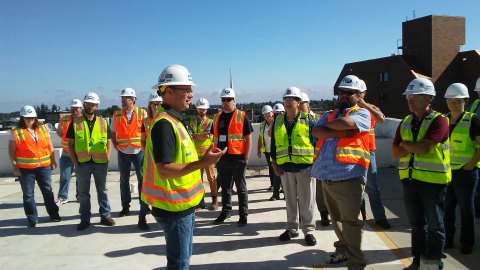Usually summer break is a time for educators to unwind from the past school year and gear up for the next school year. This summer, educators statewide spent part of their summer learning about career opportunities in construction and its supporting industries through a partnership between Associated General Contractors Oregon-Columbia Chapter (AGC) and Willamette Education Service District (WESD). The goal is for teachers, counselors, and administrators to be informed about post-secondary options in the high-wage and high-demand careers of construction and manufacturing.
The Educator Externship (Ed Ex) was born out of AGC’s Workforce Coalition, to help bridge the disconnect between industry and education, and increase workers in the skilled trade sectors. Career expos and trades fairs play a role, but industry was looking for a way to create more in-depth and relevant experiences and develop long term relationships with education. Ed Ex was designed to “educate the educators” about the depth, breadth, complexity, and diversity of careers in the construction and manufacturing industry, literally from the ground up. Educators could then feel better prepared to talk to their students about career options.
For eight days in July, elementary through high school teachers and administrators, from all disciplines, became students as they learned about safety, apprenticeship, independent training centers, general contracting, specialty contracting, manufacturing, food processing, and higher education. They also had two days of job shadow.
At the end of the eight days, teachers have two options:
- Write a lesson plan for four professional development credits, or
- Write a unit plan for four graduate credits at Western Oregon or Eastern Oregon University.
Because of various funding sources, including seed money from AGC, there is no charge to the teachers for the externship or for the credits received. The remainder of the funding is provided in different ways, through grants and professional development organizations, and is facilitated by WESD.
WOU was the first university to grant credit, based on the sectors covered during the externship. Because construction and manufacturing have so many facets, they are easily “broken open” to expose several careers. The externship participants can see the obvious aspects of construction and manufacturing, but also the back office, side such as human resources, IT, marketing, accounting, and public relations. While these occupations occur in other sectors, such as healthcare, because of HIPPA and other privacy considerations, many career opportunities cannot be shown as openly as they can in the construction and manufacturing sectors.
Core Experiences
The program consists of these core experiences:
- Day one: Orientation, safety, tours of apprenticeship and training centers
- Day two: General Contractor Day, including project engineering, estimating, design, and site tours
- Day Three: Back Office Day, which includes human resources, accounting, marketing, public relations, and elements of general contractor day, such as project management and site tours
- Day Four: Local shadow and explore (LSE) with a company close to their school, with the intent that a relationship can be built to provide classroom speakers and other resources
- Day Five: Highway, roadway, and quarry. This is actually one of the favorite days of participants as they learn about roadway and excavating, from quarry to finished highway. In the afternoon educators visit community colleges to see their specialty programs.
- Day Six: More apprenticeship and training programs; panel discussion with various sectors not visited on the regular program, such as Oregon Tradeswomen
- Day Seven: More LSE with a different company in their region
- Day Eight: University Day includes presentations and tours of programs such as OSU’s College of Engineering; debrief and begin lesson planning
Local Area Focus
When the externship program began in 2016, the ten educators were mostly from the Portland/Salem area, and the focus was all construction. This year many regions of the state participated, from Astoria to Pendleton, and Portland to Medford, so the focus shifted by region. For example, educators in the North Coast region learned about the challenges of marine construction and did an estimating project for a pier and decking replacement for the Astoria trolley. In Boardman, the Eastern Oregon participants toured many of the Port of Morrow companies. They saw food processing, big construction on a new plant, and toured an Amazon facility. In Southern Oregon, the teachers visited several large companies, including Timber Products. The Salem/Albany group toured local manufacturing plants that are major employers in the area. Despite the variety of experiences, the key employability skills were standard throughout: show up on time, work hard, be willing to learn, and be drug free.
Educator Externship is a top three finalist for an AGC of America Innovation Award in October. We have been contacted by AGC of South Texas (Corpus Christi) on how to replicate the program in their area, and we are in initial planning stages of taking the program to Washington State. Initially the goal was for educators to gain a knowledge of post-secondary options for their students, and to feel comfortable sharing industry expectations of employees. That goal has definitely been met, with nearly 11,000 potential points of contact through the educators to their students, and many strong relationships built between industry and the classroom.
Usually summer break is a time for educators to unwind from the past school year and gear up for the next school year. This summer, educators statewide spent part of their summer learning about career opportunities in construction and its supporting industries through a partnership between Associated General Contractors Oregon-Columbia Chapter (AGC) and Willamette Education Service District (WESD). The goal is for teachers, counselors, and administrators to be informed about post-secondary options in the high-wage and high-demand careers of construction and manufacturing.
The Educator Externship (Ed Ex) was born out of AGC’s Workforce Coalition, to help bridge the disconnect between industry and education, and increase workers in the skilled trade sectors. Career expos and trades fairs play a role, but industry was looking for a way to create more in-depth and relevant experiences and develop long term relationships with education. Ed Ex was designed to “educate the educators” about the depth, breadth, complexity, and diversity of careers in the construction and manufacturing industry, literally from the ground up. Educators could then feel better prepared to talk to their students about career options.
For eight days in July, elementary through high school teachers and administrators, from all disciplines, became students as they learned about safety, apprenticeship, independent training centers, general contracting, specialty contracting, manufacturing, food processing, and higher education. They also had two days of job shadow.
At the end of the eight days, teachers have two options:
- Write a lesson plan for four professional development credits, or
- Write a unit plan for four graduate credits at Western Oregon or Eastern Oregon University.
Because of various funding sources, including seed money from AGC, there is no charge to the teachers for the externship or for the credits received. The remainder of the funding is provided in different ways, through grants and professional development organizations, and is facilitated by WESD.
WOU was the first university to grant credit, based on the sectors covered during the externship. Because construction and manufacturing have so many facets, they are easily “broken open” to expose several careers. The externship participants can see the obvious aspects of construction and manufacturing, but also the back office, side such as human resources, IT, marketing, accounting, and public relations. While these occupations occur in other sectors, such as healthcare, because of HIPPA and other privacy considerations, many career opportunities cannot be shown as openly as they can in the construction and manufacturing sectors.
Core Experiences
The program consists of these core experiences:
- Day one: Orientation, safety, tours of apprenticeship and training centers
- Day two: General Contractor Day, including project engineering, estimating, design, and site tours
- Day Three: Back Office Day, which includes human resources, accounting, marketing, public relations, and elements of general contractor day, such as project management and site tours
- Day Four: Local shadow and explore (LSE) with a company close to their school, with the intent that a relationship can be built to provide classroom speakers and other resources
- Day Five: Highway, roadway, and quarry. This is actually one of the favorite days of participants as they learn about roadway and excavating, from quarry to finished highway. In the afternoon educators visit community colleges to see their specialty programs.
- Day Six: More apprenticeship and training programs; panel discussion with various sectors not visited on the regular program, such as Oregon Tradeswomen
- Day Seven: More LSE with a different company in their region
- Day Eight: University Day includes presentations and tours of programs such as OSU’s College of Engineering; debrief and begin lesson planning
Local Area Focus
When the externship program began in 2016, the ten educators were mostly from the Portland/Salem area, and the focus was all construction. This year many regions of the state participated, from Astoria to Pendleton, and Portland to Medford, so the focus shifted by region. For example, educators in the North Coast region learned about the challenges of marine construction and did an estimating project for a pier and decking replacement for the Astoria trolley. In Boardman, the Eastern Oregon participants toured many of the Port of Morrow companies. They saw food processing, big construction on a new plant, and toured an Amazon facility. In Southern Oregon, the teachers visited several large companies, including Timber Products. The Salem/Albany group toured local manufacturing plants that are major employers in the area. Despite the variety of experiences, the key employability skills were standard throughout: show up on time, work hard, be willing to learn, and be drug free.
Educator Externship is a top three finalist for an AGC of America Innovation Award in October. We have been contacted by AGC of South Texas (Corpus Christi) on how to replicate the program in their area, and we are in initial planning stages of taking the program to Washington State. Initially the goal was for educators to gain a knowledge of post-secondary options for their students, and to feel comfortable sharing industry expectations of employees. That goal has definitely been met, with nearly 11,000 potential points of contact through the educators to their students, and many strong relationships built between industry and the classroom.

